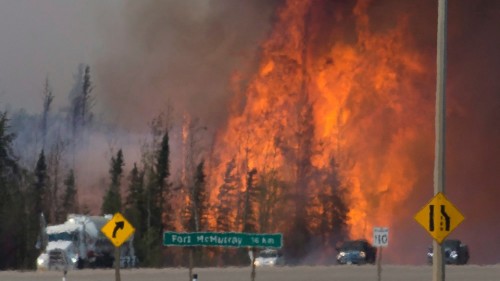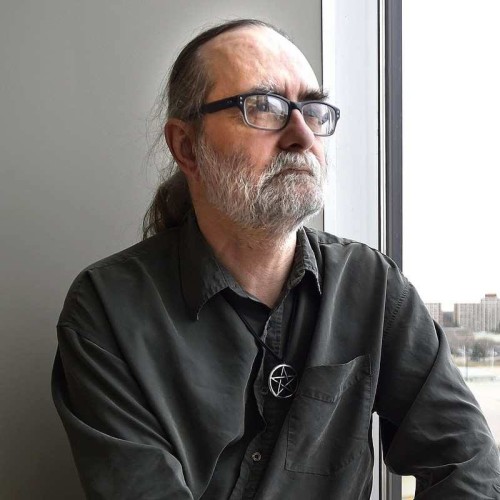FORT MCMURRAY, Alberta – On Sunday, May 1, a wildfire was reported 15 kilometers (9.3 miles) outside of the town of Fort McMurray, Alberta. This fire, encouraged by unusually dry conditions, hot temperatures and high winds, spread quickly. By the evening of May 3, officials declared a mandatory evacuation of the entire city of 88,000 inhabitants.
Fort McMurray, or “Fort Mac” as it is often referred to, is an oil industry boomtown located near the Athabasca Oil Sands in northern Alberta, Canada. Edmonton, the capitol city of the province, is Fort Mac’s nearest significant neighbor. The city lies 435 kilometres (270 mi) to the southwest of Fort Mac on Highway 63, the main route between the two communities.
The Fort McMurray fire is just one of the 41 wildfires burning across the province of Alberta. Five of those fires, including the Fort Mac fire, are considered to be out of control. As of nightfall on May 11, more than 1,715 firefighters, 101 helicopters and 26 air tankers were battling the blazes.

Wildfire blazing along Highway 63 [Photo Credit: Jonathan Hayward / THE CANADIAN PRESS]
I got a little more warning than most people. I received a text from a peace officer friend who told me we were going to be placed under a mandatory evacuation in 30 minutes. I had about 10 minutes to grab the necessities and flee in my car with my dog.
When I received the text, I went to all my neighbours and told them to pack and leave. After my car was loaded I went to my friend’s house to help her pack for her, her partner and their dog. We had 10 minutes to get their stuff. The time between when I arrived at their home and when we left their home, the air went from being slightly smoky to difficult to breathe. We then left and went down the hill from where we all lived in Abasand (a suburb of Fort Mac) via a bike path through the trees. I needed to get gas, so we went to a gas station it was closed, the fuel was emergency locked out.
We then were directed north … It took 8 hours to get to a safe place. We watched the area where our houses were burning, while we were stuck in traffic. We found lodging at a camp for oil workers with my partner and spent the night without sleeping.
In the morning I was able to secure a flight for my partner and my dog from CNRL (Canadian Natural Resources Limited). I dropped them off and then I went to my work at Suncor as I was told I was an essential worker and had to report for work. There was no room at that camp so we were waiting for a room when my peace officer friend told me we had a 30 minute window to make it south through town until the fires would close off highway 63 south again. So I called my work and informed them I was leaving and left.
The devastation surrounding us as we sped south was gut wrenching. We made it though town safely. We then ran out of gas twice on the way to Fort Saskatchewan. People were, and continue to be, so generous and kind. Random strangers gave us enough gas to get to a gas station and buy a sandwich. Now we are all staying at a friend’s house. Safe and sound.Together.
Many evacuees, like Naomi, fled north on Highway 63 to the promised safety of the oil worker’s camps, only to be told they had to head back south through the burned and burning areas around Fort Mac. This journey took most of them to the city of Edmonton, where they were received by friends, relatives and strangers. Edmonton’s local Pagan community opened its doors to ensure that evacuees had the needed shelter, food and hospitality. Kate Lomnes, a Pagan mother of four, was packing to move house when the evacuees began arriving in town. Like many other Edmonton residents, she did not hesitate to open her door to strangers. Lomnes said:
I posted on Facebook that my husband Cory and I would accept a family into our home. Our home was half-packed to move and [we have] four children, three of which are four years old. Aldeady crammed into a narrow town house, I didn’t know how we would do it. However, we have a home, walls, a roof, and means to survive. Our resources are limited, but they are meant to be shared. After all, I am Pagan and this is what we do, right? We love, we care, we share.
Not long after my initial Facebook post, a very close coven member said she had a friend that needed somewhere to house his cat. I found out after speaking to him that him and his girlfriend would not separate from their beloved meow baby, and needed a place too. There was no question; there was no pause. An airbed was dug from the abyss, as were end tables and blankets that had been previously packed. But I still felt we could do more. After a frantic $200.00 Dollarama spree, we dropped and dispersed toiletries at the relief centre and brought some home for our Fort McMurray refugees.

University of Alberta Wiccan Chaplin Samuel Wagar [Photo Credit: Ed Kaiser]
As a chaplain, I am part of the counseling and support team for the refugees. The University has mobilized its student services and mental health support, along with city and provincial emergency response.“
My specific responsibility is to provide spiritual care – meditation, prayer, a quiet place to reflect. We’ve set up an interfaith chapel space as a headquarters for that.
I’m also a resource person to direct people to other things they may need. I’m getting a crash course in social services and emergency resources. Luckily, the provincial and federal responses have been exceptional (especially considering the scope of the evacuation).
The organizing team of PanFest, a weekend long camping festival that happens just south of Edmonton every August at Lughnasadh, have announced that all funds raised during the their recent used book sale will be donated to the Canadian Red Cross fund for evacuees. PanFest chose the Red Cross due to the recent announcement that money donated to aid evacuees will be matched by the Government of Canada.
 Fire officials are still investigating the cause of the blaze, and human carelessness is suspected. What is known is that the extremely dry conditions that made this fire get out of control can be attributed to climate change. Greenhouse gas emissions cause higher overall temperatures and decreased precipitation, leaving forests drier and more prone to ignition. The influence the oil industry has on these factors is a topic of fierce debate among Pagans. Wagar said:
Fire officials are still investigating the cause of the blaze, and human carelessness is suspected. What is known is that the extremely dry conditions that made this fire get out of control can be attributed to climate change. Greenhouse gas emissions cause higher overall temperatures and decreased precipitation, leaving forests drier and more prone to ignition. The influence the oil industry has on these factors is a topic of fierce debate among Pagans. Wagar said:
Climate change is real. There was much less snow this winter, the spring came earlier and much hotter than it was used to. The boreal forest is tinder dry. This is likely to be the new normal, just like drought in most of the United States, the sea level rise, and rendering uninhabitable of many tropical areas. The moral imperative on Pagans to do something to stop climate change is beyond theoretical now. Mother Earth with adjust, this current great extinction may proceed along, but humanity will not survive.
I keep hoping that humanity at large, or at least our Pagan community, will be shocked out of complacency as the ecological disaster of global warming unfolds.
But too many of us are complicit. Here in Alberta, so much of our economy is presently tied into carbon pollution, so many jobs. It is very difficult to ask people to stop working in oil and gas, when capitalism does not provide other options.
Lomnes added, “I know many Pagans are viewing this climate disaster as Gaia on a furious cleansing spree. Others see it as a result in human’s carelessness contributing to Global Warming. I will leave those opinions to the scientfically educated more experienced Pagans. It may be one or the other, or none it all, but we all know we should be doing our part in saving The Earth.”
The most recent on the ground reports state that 85% of Fort Mac is still standing, but the damage to the community goes beyond the immediate destruction from the flames. The power grid is down and the water in the area is not safe to drink. There is an air quality warning in effect because of the heavy smoke hanging over the area. It is not yet known when it will be safe for residents to return to their homes, or if they even still have homes. The government of Alberta website warns that residents of Fort McMurray should not expect that homecoming for an extended period of time.
After their dramatic escape from the flames, Naomi, her partner and their dog are safe. They made their way to Calgary, another large city in Alberta, 655 km (407 miles) south of Fort Mac. For now, the future for them is uncertain, and their house and its contents are gone. Naomi wrote:
My family and I have lost everything. We have left with a little bit more than the clothes on our backs. I am so blessed and thankful that we are together and safe. Everything is extremely surreal right now. I’m still in shock. To my fellow Pagan community I would just want people to know that this disaster is horrible, terrifying, and heart breaking. Everyone got out safe and that is a miracle. Please don’t blanket judge people who live and work up here. Just see us as a community that has been decimated, is strong and will persevere. Thank you for all your concern and support. It is much needed and appreciated.
As of press time, there have been no reported human casualties of this fire. Sadly, two teenagers died when their vehicle collided with a tractor-trailer just outside of Lac La Biche, Alberta during the evacuation. It is predicted by Alberta’s fire authorities i that these fires will be burning for some time to come, and that the best help they can hope for would be for a substantial amount of rain to help put out the flames.
The Wild Hunt is not responsible for links to external content.
To join a conversation on this post:
Visit our The Wild Hunt subreddit! Point your favorite browser to https://www.reddit.com/r/The_Wild_Hunt_News/, then click “JOIN”. Make sure to click the bell, too, to be notified of new articles posted to our subreddit.

Three different short comments:
The actions of the Canadian government and public agencies in this disaster seem to be exemplary. Civil society seems to be holding on too. Let us hope our northern neighbor has some breathing room to recover.
I also hope that when Pagan-oriented relief funds start to be set up, The Wild Hunt will not only publicize them but try to do a little investigation, to give those of us at a distance guidance as to the best places to send donations.
I think Sam Wagar’s prediction that “humanity will not survive” climate change is overly pessimistic. We’re currently at 400 ppm carbon dioxide, so the planet is due for rapid climate change even if we go cold turkey on fossil fuel use tomorrow. Climate change will be very disruptive to complex societies. Industrial civilization may not survive. Perhaps the human population will be reduced to a point where cities do not survive. However, homo sapiens is a highly mobile, adaptable generalist species. It spread from Africa to every climate and continent except (as far as we know) Antarctica via small roving bands using stone age technology. If this planet can support mammalian life anywhere, it’s likely to support some human beings, unless we have really bad luck.
http://wildhunt.org/2016/05/the-wildfire-crisis-in-fort-mcmurray.html#disqus_thread
The hard thing to realize is we are experiencing the new normal. This is not a temporary spike, but a beginning of much rougher times that will affect a great many people. It will be climate refugees that will make our present war refugee problem look like a walk in the park as we will be seeing many more millions of people on the move over the next few generation. We need to start figuring where we are going to put them, how to raise the money, what the cost is going to be and get started now.
Where I live, in a semi-tropical forest, increased precipitation has occurred, not decreased precipitation. We are losing football-sized land every day down here along the Gulf Coast in the United States due to the seas rising. But it won’t be for long.
Climate change is real. But whether our planet will be warmer is up for grabs. Climate scientists are now saying we are looking at a mini ice-age by the 2020s if the sunspot cycle is low. If the sunspot cycle increases, the mini ice age will be put off until the 2030s. There is no getting around it. New informative technology is allowing climate scientists to better understand this particular global warming event as part of a larger climate cycle. So you might want to start putting your dollars into thermal underwear investments.
Could you please provide a reference or a link to this near-term mini-ice-age projection?
Baruch, check out Mitch Battros at Science of Cycles Newsletter (formerly known as Earth Changes Media). He has written several articles re: the cycles of cooling and warming. One of his articles was titled The Science of Cycles vs The Patterns of Human Evolution/Devolution. Then there is Michael Mandeville’s newsletter Earth Changes Bulletin. In his May 9, 2016 newsletter, he says, “The Coming Cold Era: The key question to watch now: how long will Solar Min be? An unusually long one will probably indicate the return of the Maunder Minimum cold era. I think the key pivot year by which we will know will be 2021. Keep in mind that there are NO proven models of Solar Activity which allow prediction of Solar Activity except the planetary alignments for activity highs and statistical comparison of the lengths of Solar Cycles (long ones attend lower activity in the Sun). Accordingly, at the moment all discussion about a coming cold period is speculative. (The cold speculation has fairly solid ground and thus is worth watching very carefully).” He has other articles where he talks about the coming mini-ice-age sometime in the 2020s and if the solar activity increases, then sometime in the 2030s. You can access him for now at:https://groups.yahoo.com/neo/groups/earthchange-bulletins/conversations/messages. His website is still being worked on and its URL is http://www.earthchanges-bulletin.com/. I have also read it in some climate journal articles posted on the web. I don’t have those URLS at this moment.
Thank you!